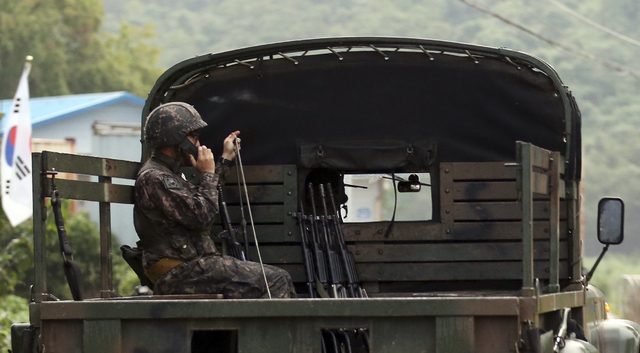PYONGYANG, North Korea (AP) — South Korea fired dozens of shells Thursday at North Korea after claiming the North lobbed a single rocket at a South Korean town broadcasting anti-North Korean propaganda near the world’s most heavily armed border. The
PYONGYANG, North Korea (AP) — South Korea fired dozens of shells Thursday at North Korea after claiming the North lobbed a single rocket at a South Korean town broadcasting anti-North Korean propaganda near the world’s most heavily armed border. The North denied it fired any shots and warned of retaliation for what it called a serious provocation.
Officials in Seoul said the North fired the rocket across the Demilitarized Zone to back up an earlier threat to attack South Korean border loudspeakers that, after a lull of 11 years, have started broadcasting anti-Pyongyang propaganda. But the Supreme Headquarters of the Korean People’s Army issued a statement later Thursday denying it had launched any shots at the South.
“Using the pretext that our forces fired one shell to the south, which is not true, it made reckless moves by firing 36 shells at our military posts,” said the statement, published in Korean by the North’s state media. It said the shells landed near four military posts, but caused no injuries.
“This reckless shelling incident is a serious military provocation to our sacred territory and military posts which is intolerable,” it said.
The incident comes amid rising tensions between the rival Koreas.
South Korea and the United States are holding annual military drills that the North has long said are a rehearsal for the invasion of their country and Seoul recently restarted the propaganda broadcasts because it claims the North planted land mines on the South Korean side of the DMZ that maimed two South Korean soldiers earlier this month. North Korea has denied that claim as well.
South Korea’s Defense Ministry said in a statement that its artillery shells landed at the site where North Korea had fired its rocket. There were no other details from the military.
South Korean President Park Geun-hye convened an emergency National Security Council meeting and ordered South Korea’s military to “resolutely” deal with any provocation by North Korea. North Korea, meanwhile, convened an enlarged emergency meeting of the central military commission of its ruling party.
North Korea didn’t respond militarily to South Korea’s artillery barrage, but warned in a message it will take further military action within 48 hours if South Korea doesn’t pull down the loudspeakers, according to South Korea’s Defense Ministry.
North Korea, which has also restarted its own propaganda broadcasts, is extremely sensitive to any criticism of the government run by leader Kim Jong Un, whose family has ruled since the North was founded in 1948.
It has said the broadcasts are tantamount to an act of war.
In Washington, State Department spokesman John Kirby said the U.S. was concerned by the firing of a projectile into South Korea from the North and was closely monitoring the situation.
“These kinds of provocative actions only heighten tensions and we call on Pyongyang to refrain from actions and rhetoric that threaten regional peace and security,” Kirby said, reiterating the U.S. commitment to its security alliance with South Korea.
About 80 residents in the town where South Korean officials say the shell fell, Yeoncheon, were evacuated to underground bunkers, and authorities urged other residents to evacuate, a Yeoncheon official said, requesting anonymity because he wasn’t authorized to speak to the media.
In the nearby border city of Paju, residents were asked to stay home. On Ganghwa Island, residents in villages near a site where South Korea operates one of its loudspeakers were also evacuated, according to island officials. South Korea’s Yonhap news agency reported that a total of about 2,000 residents along the border were evacuated.
South Korea has said the two soldiers wounded from the mine explosions were on a routine patrol in the southern part of the DMZ that separates the two Koreas. One soldier lost both legs and the other one leg.
While the Koreas regularly exchange hostile rhetoric, it is also not unusual for fighting to occasionally erupt.
Last October, North Korean troops opened fire at areas in Yeoncheon, after South Korean activists launched balloons there that carried propaganda leaflets across the border. South Korea returned fire, but no casualties were reported. Later in October, border guards from the two Koreas again exchanged gunfire along the border, without any casualties.
Before that, the Koreas tangled in a deadly artillery exchange in 2010, when North Korean artillery strikes on a South Korean border island killed four South Koreans. Earlier in 2010, an alleged North Korean torpedo attack killed 46 South Korean sailors.
The Koreas’ mine-strewn DMZ is a legacy of the 1950-53 Korean War, which ended with an armistice, not a peace treaty, leaving the Korean Peninsula still technically in a state of war.



